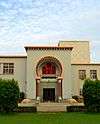Syed Ahmad Khan
| Sir Syed Ahmad Khan | |
|---|---|
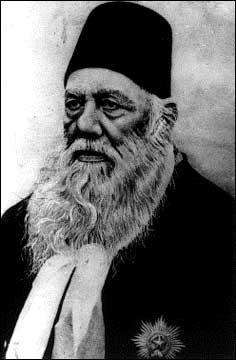 | |
| Born |
17 October 1817 Delhi, Mughal Empire |
| Died |
27 March 1898 (aged 80) Aligarh, British India |
| Nationality | British Indian |
| Other names | Sir Syed |
| Alma mater |
Edinburgh University East India Company College |
| Notable work |
The Mohammadan Commentary on the Holy Bible (Tafsir on BIBLE. |
| Awards |
|
| Era | 19th century |
| School | Islamic and Renaissance philosophy |
| Institutions |
East India Company Indian Judicial Branch Aligarh Muslim University Punjab University Government College University |
Main interests | Pragmatism, Metaphysics, language, aesthetics, and Islam and Christianity |
Notable ideas | Muslim adoption of Western ideas |
|
Influences
| |
|
Influenced
| |
Syed Ahmad Taqvi bin Syed Muhammad Muttaqi[1] KCSI (Urdu: سید احمد خان; 17 October 1817 – 27 March 1898), commonly known as Sir Syed Ahmad Khan, was an Indian Muslim pragmatist,[2] Islamic reformist,[3][4] philosopher of nineteenth century British India and the first who named the term "Two Nation theory"[5][6] to the theory of separate nation of Muhammad Ali Jinnah. Born into a family with strong ties with Mughal court, Syed studied the Quran and sciences within the court. He was awarded honorary LLD from the University of Edinburgh.[7]
In 1838, Syed Ahmad entered the service of East India Company and went on to become a judge at a Small Causes Court in 1867, and retired from service in 1876. During the Indian Rebellion of 1857, he remained, loyal to the British Empire and was noted for his actions in saving European lives.[3] After the rebellion, he penned the booklet The Causes of the Indian Mutiny – a daring critique, at the time, of British policies that he blamed for causing the revolt. Believing that the future of Muslims was threatened by the rigidity of their orthodox outlook, Sir Syed began promoting Western–style scientific education by founding modern schools and journals and organising Muslim entrepreneurs.
In 1859, Syed established Gulshan School at Muradabad, Victoria School at Ghazipur in 1863, and a scientific society for Muslims in 1864. In 1875, founded the Muhammadan Anglo-Oriental College, the first Muslim university in South Asia.[8] During his career, Syed repeatedly called upon Muslims to loyally serve the British Empire and promoted the adoption of Urdu as the lingua franca of all Indian Muslims. Syed heavily critiqued the Indian National Congress.[9]
Syed maintains a strong legacy in Pakistan and Indian Muslims. He strongly influenced other Muslim leaders including Allama Iqbal and Jinnah. His advocacy of Islam's rationalist (Muʿtazila) tradition, and at broader, radical reinterpretation of the Quran to make it compatible with science and modernity, continues to influence the global Islamic reformation.[10] Many universities and public buildings in Pakistan bear Sir Syed's name.[11]
Aligarh Muslim University celebrated his 200th birth centenary with much enthusiasm on 17 October 2017. Former President of India shri Pranab Mukherjee was the chief guest.[12][13]
| “ | Do not show the face of Islam to others; instead show your face as the follower of true Islam representing character, knowledge, tolerance and piety. | ” |
| — Sir Syed Ahmed Khan | ||
Early life
Sir Syed Ahmed 'Khan Bahadur' was born on 17 October 1817 to a Syed family in Delhi, which was the capital of the Mughal Empire. His family were descendant of Muhammad[14] and then moved to the Indian subcontinent[15] in the ruling times of Mughal emperor Akbar–I. Many generations of his family had since been highly connected with the administrative position in Mughal Empire. His maternal grandfather Khwaja Fariduddin served as Wazir (lit. Minister) in the court of Emperor Akbar–II.[16] His paternal grandfather Syed Hadi Jawwad bin Imaduddin held a mansab (lit. General)– a high-ranking administrative position and honorary name of "Mir Jawwad Ali Khan" in the court of Emperor Alamgir II. Sir Syed's father, Syed Muttaqi Muhammad bin Hadi Khan, was personally close to Emperor Akbar–II and served as his personal adviser.[17]
However, Syed Ahmad was born at a time when his father was regional insurrections aided and led by the East India Company, and the British Empire had diminished the extent and power of the Mughal state, reducing its monarch to figurehead. With his elder brother Syed Muhammad bin Muttaqi Khan, Sir Syed was raised in a large house in a wealthy area of the city. They were raised in strict accordance with Mughal noble traditions and exposed to politics. Their mother Aziz-un-Nisa played a formative role in Sir Syed's early life, raising him with rigid discipline with a strong emphasis on modern education.[18] Sir Syed was taught to read and understand the Qur'an by a female tutor, which was unusual at the time. He received an education traditional to Muslim nobility in Delhi. Under the charge of Lord Wellesley , Sir Syed was trained in Persian, Arabic, Urdu and orthodox religious subjects. He read the works of Muslim scholars and writers such as Sahbai, Rumi and Ghalib. Other tutors instructed him in mathematics, astronomy and Islamic jurisprudence.[16][19] Sir Syed was also adept at swimming, wrestling and other sports. He took an active part in the Mughal court's cultural activities.[20]
Syed Ahmad's elder brother founded the city's first printing press in the Urdu language along with the journal Sayyad-ul-Akbar. Sir Syed pursued the study of medicine for several years but did not complete the course.[16] Until the death of his father in 1838, Sir Syed had lived a life customary for an affluent young Muslim noble.[16] Upon his father's death, he inherited the titles of his grandfather and father and was awarded the title of Arif Jung by the emperor Bahadur Shah Zafar.[21] Financial difficulties put an end to Sir Syed's formal education, although he continued to study in private, using books on a variety of subjects.[20] Sir Syed assumed editorship of his brother's journal and rejected offers of employment from the Mughal court.[20]
Career
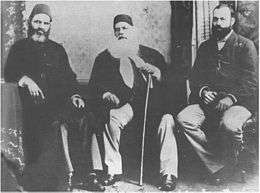
Having recognized the steady decline in Mughal political power, Sir Syed decided to enter the service of the East India Company. He could not enter the English civil service because it was only in the 1860s that natives were admitted. He did not attend the East India Company College which did not grant degrees.[22] His first appointment was as a Serestadar (lit. Clerk) at the courts of law in Agra, responsible for record-keeping and managing court affairs.[22] In 1840, he was promoted to the title of munshi. In 1858, he was appointed to a high-ranking post at the court in Muradabad, where he began working on his most famous literary work.
Acquainted with high-ranking British officials, Sir Syed obtained close knowledge about British colonial politics during his service at the courts. At the outbreak of the Indian rebellion, on 10 May 1857, Sir Syed was serving as the chief assessment officer at the court in Bijnor. Northern India became the scene of the most intense fighting.[23] The conflict had left large numbers of civilians dead. Erstwhile centres of Muslim power such as Delhi, Agra, Lucknow and Kanpur were severely affected. Sir Syed was personally affected by the violence and the ending of the Mughal dynasty amongst many other long-standing kingdoms. Sir Syed and many other Muslims took this as a defeat of Muslim society.[24] He lost several close relatives who died in the violence. Although he succeeded in rescuing his mother from the turmoil, she died in Meerut, owing to the privations she had experienced.[23]
Social reforms in the Muslim society were initiated by Abdul Latif who founded "The Mohammedan Literary Society" in Bengal. Sir Syed Ahmed Khan established the MAO College which eventually became the Aligarh Muslim University. He opposed ignorance, superstitions and evil customs prevalent in Indian Muslim society. He firmly believed that Muslim society would not progress without the acquisition of western education and science. As time passed, Sir Syed began stressing on the idea of pragmatic modernism and started advocating for strong interfaith relations between Islam and Christianity.
Causes of the Indian Revolt
Sir Syed supported the British during the 1857 uprising, a role which has been criticised by some nationalists such as Jamaluddin Afghani. In 1859 Sir Syed published the booklet Asbab-e-Baghawat-e-Hind (The Causes of the Indian Revolt) in which he studied the causes of the Indian revolt. In this, his most famous work, he rejected the common notion that the conspiracy was planned by Muslim élites, who resented the diminishing influence of Muslim monarchs. He blamed the British East India Company for its aggressive expansion as well as the ignorance of British politicians regarding Indian culture. Sir Syed advised the British to appoint Muslims to assist in administration, to prevent what he called ‘haramzadgi’ (a vulgar deed) such as the mutiny.[25]
Maulana Altaf Hussain Hali wrote in the biography of Sir Syed that:
"As soon as Sir Syed reached Muradabad, he began to write the pamphlet entitled 'The Causes of the Indian Revolt' (Asbab-e-Baghawat-e-Hind), in which he did his best to clear the people of India, and especially the Muslims, of the charge of Mutiny. In spite of the obvious danger, he made a courageous and thorough report of the accusations people were making against the Government and refused the theory which the British had invented to explain the causes of the Mutiny."[26]
When the work was finished, without waiting for an English translation, Sir Syed sent the Urdu version to be printed at the Mufassilat Gazette Press in Agra. Within a few weeks, he received 500 copies back from the printers. His friend warned him not to send the pamphlet to Parliament or to the Government of India. Rae Shankar Das, a great friend of Sir Syed, begged him to burn the books rather than put his life in danger. Sir Syed replied that he was bringing these matters to the attention of the British for the good of his own people, of his country, and of the government itself. He said that if he came to any harm while doing something that would greatly benefit the rulers and the subjects of India alike, he would gladly suffer whatever befell him. When Rae Shankar Das saw that Sir Syed's mind was made up and nothing could be done to change it, he wept and remained silent. After performing a supplementary prayer and asking God's blessing, Sir Syed sent almost all the 500 copies of his pamphlet to England, one to the government, and kept the rest himself.
When the government of India had the book translated and presented before the Council, Lord Canning, the governor-general, and Sir Bartle Frere accepted it as a sincere and friendly report. The foreign secretary Cecil Beadon, however, severely attacked it, calling it 'an extremely seditious pamphlet'. He wanted a proper inquiry into the matter and said that the author, unless he could give a satisfactory explanation, should be harshly dealt with. Since no other member of the Council agreed with his opinion, his attack did no harm.
Later, Sir Syed was invited to attend Lord Canning's durbar in Farrukhabad and happened to meet the foreign secretary there. He told Sir Syed that he was displeased with the pamphlet and added that if he had really had the government's interests at heart, he would not have made his opinion known in this way throughout the country; he would have communicated it directly to the government. Sir Syed replied that he had only had 500 copies printed, the majority of which he had sent to England, one had been given to the government of India, and the remaining copies were still in his possession. Furthermore, he had the receipt to prove it. He was aware, he added, that the view of the rulers had been distorted by the stress and anxieties of the times, which made it difficult to put even the most straightforward problem in its right perspective. It was for this reason that he had not communicated his thoughts publicly. He promised that for every copy that could be found circulating in India he would personally pay 1,000 rupees. At first, Beadon was not convinced and asked Sir Syed over and over again if he was sure that no other copy had been distributed in India. Sir Syed reassured him on this matter, and Beadon never mentioned it again. Later he became one of Sir Syed's strongest supporters.
Many official translations were made of the Urdu text of The Causes of the Indian Revolt. The one undertaken by the India Office formed the subject of many discussions and debates.[27] The pamphlet was also translated by the government of India and several members of parliament, but no version was offered to the public. A translation which had been started by a government official was finished by Sir Syed's great friend, Colonel G.F.I. Graham, and finally published in 1873.[28]
Influence of Mirza Ghalib

In 1855, he finished his scholarly, well researched and illustrated edition of Abul Fazl's Ai'n-e Akbari, itself an extraordinarily difficult book. Having finished the work to his satisfaction, and believing that Mirza Asadullah Khan Ghalib was a person who would appreciate his labours, Syed Ahmad approached the great Ghalib to write a taqriz (in the convention of the times, a laudatory foreword) for it. Ghalib obliged, but what he did produce was a short Persian poem castigating the Ai'n-e Akbari, and by implication, the imperial, sumptuous, literate and learned Mughal culture of which it was a product. The least that could be said against it was that the book had little value even as an antique document. Ghalib practically reprimanded Syed Ahmad Khan for wasting his talents and time on dead things. Worse, he praised sky-high the "sahibs of England" who at that time held all the keys to all the a’ins in this world.[29]
The poem was unexpected, but it came at the time when Syed Ahmad Khan's thought and feelings themselves were inclining toward change. Ghalib seemed to be acutely aware of a European[English]-sponsored change in world polity, especially Indian polity. Syed Ahmad might well have been piqued at Ghalib's admonitions, but he would also have realized that Ghalib's reading of the situation, though not nuanced enough, was basically accurate. Syed Ahmad Khan may also have felt that he, being better informed about the English and the outside world, should have himself seen the change that now seemed to be just round the corner.
Sir Syed Ahmad Khan never again wrote a word in praise of the Ai'n-e Akbari and in fact gave up taking an active interest in history and archaeology. He did edit another two historical texts over the next few years, but neither of them was anything like the Ai'n: a vast and triumphalist document on the governance of Akbar.[30]
Scholarly works
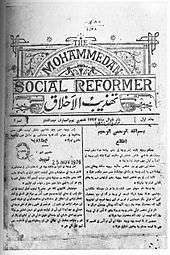
While continuing to work as a junior clerk, Sir Syed began focusing on writing, from the age of 23 (in 1840), on various subjects (from mechanics to educational issues), mainly in Urdu, where he wrote, at least, 6000 pages.[31][32] His career as an author began when he published a series of treatises in Urdu on religious subjects in 1842. He published the book Asaar-us-sanadeed (Great Monuments) documenting antiquities of Delhi dating from the medieval era. This work earned him the reputation of a cultured scholar. In 1842, he completed the Jila-ul-Qulub bi Zikr-il Mahbub and the Tuhfa-i-Hasan, along with the Tahsil fi jar-i-Saqil in 1844. These works focused on religious and cultural subjects. In 1852, he published the two works Namiqa dar bayan masala tasawwur-i-Shaikh and Silsilat ul-Mulk. He released the second edition of Ansar-as-sanadid in 1854.[33] He also started work on a commentary on the Bible – the first by a Muslim – in which he argued that Islam was the closest religion to Christianity, with a common lineage from Abrahamic religions.[16] He began with Genesis and Matthew, the first books of the Old and New Testament, but quit his project before even completing those first two. His other writings such as Loyal Muhammadans of India, Tabyin-ul-Kalam and A Series of Essays on the Life of Muhammad and Subjects Subsidiary Therein helped to create cordial relations between the British authorities and the Muslim community.
Fellows
He was appointed the fellow of the Calcutta University and Allahabad University by the Viceroy in the year 1876 and 1887 respectively.[34]
Legal works
- 1. Act No. 10 (Stamp Act) 1862.
- 2. Act No. 14 (Limitation) Act 1859–1864.
- 3. Act No. 16 (Regarding registration documents) – Allyson, 1864.
- 4. Act No. 18 (Regarding women's rights) 1866.
Religious works
- 4. Ahkam Tu'am Ahl-Kitab, Kanpur, 1868.
- 5. Al-Du'a Wa'l Istajaba, Agra, 1892.
- 6. Al-Nazar Fi Ba'z Masa'il Imam Al-Ghazzali, Agra.
- 7. Izalat ul-Chain as Zi'al Qarnain, Agra, 1889.
- 8. Zila al-Qulub ba Zikr al-Mahbub, Delhi, 1843.
- 9. Khulq al-Insan ala ma fi al-Quran, Agra, 1892.
- 10. Kimiya-i-Sa'dat, 2 fasl, 1883.
- 11. Mazumm ba nisbat tanazzul ulum-i-diniya wa Arabiya wa falsafa-i-Yunaniya, Agra, 1857.
- 12. Namiqa fi Bayan Mas'ala Tasawwur al-Shaikh, Aligarh, 1883.
- 13. Rah-i-Sunnat dar rad-i-bid'at, Aligarh, 1883.
- 14. Risala Ibtal-i-Ghulami, Agra, 1893.
- 15. Risala ho wal Mojud, 1880.
- 16. Risala Tahqiq Lafzi-i-Nassara, 1860.
- 17. Tabyin-ul-Kalam fi Tafsir-al-turat-wa'l Injil ala Mullat-al-Islam (The Mohomedan Commentary on the Holy Bible).
- 18. Tafsir-ul-Qura'n
- Vol. I Aligarh, 1880,
- Vol. II Aligarh, 1882, Agra, 1903.
- Vol. III Aligarh, 1885
- Vol. IV Aligarh, 1888
- Vol. V Aligarh, 1892.
- Vol. VI Aligarh, 1895
- Vol. VII Agra, 1904.
- 19. Tafsir al-Jinn Wa'l Jan ala ma fi al-Qur'an, Rahmani Press, Lahore, 1893, Agra, 1891.
- 20. Tafsir-a-Samawat, Agra.
- 21. Tahrir fi Usul al-Tafsir, Agra, 1892.
- 22. Tarjama fawa'id al-afkar fi amal al-farjar, Delhi 1846.
- 23. Tarqim fi qisa ashab al-kahf wal-Raqim, Agra, 1889.
- 24. Tasfiyad al'Aquid (Being the correspondence between Syed Ahmad Khan and Maulana Muhammad Qasim of Deobund).
- 25. Asbab-e-Baghawat-e-Hind (Reasons for the Indian Revolt of 1857) 1875
Historical works
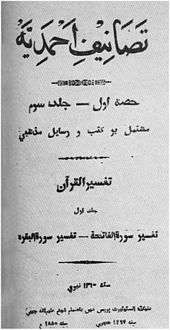
- 25. A'in-e-Akbari (Edition with Illustration), Delhi.
- 26. Asrar-us-Sanadid (i) Syed-ul-Akhbar, 1847, (II) Mata-i-Sultani, 1852.
- 27. Description des monument de Delhi in 1852, D'a Pre Le Texte Hindostani De Saiyid Ahmad Khan (tr. by M. Garcin De Tassy), Paris, 1861.
- 28. Jam-i-Jum, Akbarabad, 1940.
- 29. Silsilat-ul-Muluk, Musaraf ul Mataba', Delhi, 1852.
- 30. Tarikh-i-Firoz Shahi (Edition), Asiatic Society, Calcutta, 1862.
- 31. Tuzuk-i-Jahangiri (edition Aligarh, 1864).
Biographical works
- 32. Al-Khutbat al-Ahmadiya fi'l Arab wa'I Sirat al-Muhammadiya : Aligarh, 1900, English translation, London, 1869–70.
- 33. Sirat-i-Faridiya, Agra, 1896.
- 34. Tuhfa-i-Hasan, Aligarh, 1883.
Political works
- 35. Asbab-i-Baghawat-e-Hind, Urdu 1858 and English edition, Banaras.
- 36. Lecture Indian National Congress Madras Par, Kanpur, 1887.
- 37. Lectures on the Act XVI of 1864, delivered on 4 December 1864 for the Scientific Society, Allygurh, 1864.
- 38. Musalmanon ki qismat ka faisla (taqarir-e-Syed Ahmad Khan wa Syed Mehdi Ali Khan etc.) Agra, 1894.
- 39. On Hunter's: Our Indian Mussulmans' London, 1872.
- 40. Present State of Indian Politics (Consisting of lectures and Speeches) Allahabad, 1888.
- 41. Sarkashi Zilla Binjor, Agra 1858.
Lectures
- 42. Iltimas be Khidmat Sakinan-i-Hindustan dar bad tarraqi ta' lim ahl-i.Hind, Ghazipore, 1863.
- 43. Lecture dar bab targhib wa tahris talim itfal-i-Musalmanan, in 1895, Agra 1896.
- 44. Lecture Madrasaat ul-Ulum Aligarh Key Tarikhi halat
UykjhuhfPar, Agra. 1889.
- 45. Lecture Ijlas Dahum Muhammadan Educational Conference, Agra, 1896.
- 46. Lecture Muta'liq Ijlas Yazdahum Muhammadan Educational Conference, Agra, 1896.
- 47. Majmu'a Resolution Haye dah sala (Resolutions passed by the Muhammadan Anglo-Oriental Educational Conference from 1886 to 1895) ed. by Sir Syed Ahmad, Agra, 1896.
- 48. Report Salana (Annual Report of the Boarding House of Madrasat-ul-Ulum 1879–1880).

Collected works
- 49. Khutut-i-Sir Syed, ed Ross Masud, 1924.
- 50. Majuma Lecture Kaye Sir Syed ed. Munshi Sirajuddin, Sadhora 1892.
- 51. Maqalat-i-Sir-Syed ed. by 'Abdullah Khvesgri, Aligarh, 1952.
- 52. Maqalat-i-Sir Syed, ed. By Muhammad Ismail, Lahore,
- 53. Makatib-i-Sir Syed, Mustaq Husain, Delhi, 1960.
- 54. Maktubat-i-Sir Syed, Muhammad Ismail Panipati, Lahore, 1959.
- 55. Makummal Majumua Lectures wa speeches. ed. Malik Fazaluddin, Lahore, 1900.
- 56. Muktubat al-Khullan ed. Mohd. Usman Maqbul, Aligarh 1915.
- 57. Tasanif-i-Ahmadiya (Collection of Syed Ahmad Khan's works on religions topics) in 8 parts.
- 58. Stress on Holy Quran.
- 59. Reformation of Faith.
Miscellaneous
- 58. On the Use of the Sector (Urdu), Syed-ul-Akbar, 1846.
- 59. Qaul-i-Matin dar Ibtal-i-Harkat i Zamin, Delhi, 1848.
- 60. Tashil fi Jar-a-Saqil, Agra, 1844.
- 61. Ik Nadan Khuda Parast aur Dana dunyadar Ki Kahani, Badaon, 1910.
- 62. Kalamat-ul-Haqq, Aligarh
Journals, reports, and proceedings
- 1. Tehzeeb-ul-Ikhlaq.
- 2. Aligarh Institute Gazette.
- 3. Proceedings of the Muhammadens Educational Conference.
- 4. An Account of the Loyal Muhammadans of India, Parts I, II, III, Moufussel Press, Meerut, 1860.
- 5. Proceedings of the Scientific Society.
- 6. By-Laws of the Scientific Society.
- 7. Addresses and speeches relating to the Muhammadan Anglo-Oriental College in Aligarh (1875–1898) ed. Nawab Mohsin-ul-Mulk, Aligarh, 1898.[35]
Muslim reformer
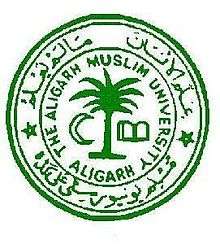 The motto of Aligarh University,
Taught man that which he knew not. (Qur'an 96:5) |
Through the 1850s, Syed Ahmed Khan began developing a strong passion for education. While pursuing studies of different subjects including European jurisprudence, Sir Syed began to realise the advantages of Western-style education, which was being offered at newly established colleges across India. Despite being a devout Muslim, Sir Syed criticised the influence of traditional dogma and religious orthodoxy, which had made most Indian Muslims suspicious of British influences.[36] Sir Syed began feeling increasingly concerned for the future of Muslim communities.[36] A scion of Mughal nobility, Sir Syed had been reared in the finest traditions of Muslim élite culture and was aware of the steady decline of Muslim political power across India. The animosity between the British and Muslims before and after the rebellion (Independence War) of 1857 threatened to marginalise Muslim communities across India for many generations.[36] Sir Syed intensified his work to promote co-operation with British authorities, promoting loyalty to the Empire amongst Indian Muslims. Committed to working for the upliftment of Muslims, Sir Syed founded a modern madrassa in Muradabad in 1859; this was one of the first religious schools to impart scientific education. Sir Syed also worked on social causes, helping to organise relief for the famine-struck people of North-West Province in 1860. He established another modern school in Ghazipur in 1863.
Upon his transfer to Aligarh in 1864, Sir Syed began working wholeheartedly as an educator. He founded the Scientific Society of Aligarh, the first scientific association of its kind in India. Modelling it after the Royal Society and the Royal Asiatic Society,[19] Sir Syed assembled Muslim scholars from different parts of the country. The Society held annual conferences, disbursed funds for educational causes and regularly published a journal on scientific subjects in English and Urdu. Sir Syed felt that the socio-economic future of Muslims was threatened by their orthodox aversions to modern science and technology.[36] He published many writings promoting liberal, rational interpretations of Islamic scriptures. One example was the reaction to his argument – which appeared in his tafsir (exegesis) of the Quran – that riba referred to interest charges when lending money to the poor, but not to the rich, nor to borrowers "in trade or in industry", since this finance supported "trade, national welfare and prosperity". While many jurists declared all interest to be riba, (according to Sir Syed) this was based "on their own authority and deduction" rather than the Quran.[37]
Many other orthodox Sunni schools condemned him as out of the fold of Islam i.e. kafir.[38] Many of his own friends, like Nawab Muhsin ul Mulk, expressed their significant reservations at his religious ideas (many of which were expounded in his commentary of Qur'an)[39]. According to J.M.S. Balijon his ideas created "a real hurricane of protests and outbursts of wrath" among by local clerics "in every town and village" in Muslim India, who issued fatawa "declaring him to be a kafir" (unbeliever).[40] He was also accused of having converted to Christianity.[41]
Maulana Qasim Nanautawi, the founder of Darul 'Uloom Deoband, expressed in a letter to an anacquaintance of his and Sir Syed's:
"No doubt, I greatly admire, as per what I've heard, Syed (Ahmad) Sahab's courage (Ūlul Azmi) and concern for the Muslims (Dardmandi e Ahl e Islam). For this if I shall express my affection for him, it will be rightful. However, similar to this (or rather more than this), upon hearing about his disturbed (Fāsid) beliefs, I have deep complains and sorrow for him"[42]
Maulana Qasim Nanautawi wrote directly to Sir Syed as well, explaining him some of his "noteworthy" mistakes. This correspondence was published as "Tasfiyat ul Aqaaid" in 1887 C.E [43]
Advocacy of Urdu
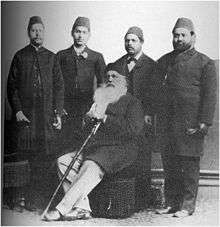
The onset of the Hindi-Urdu controversy of 1867 saw the emergence of Sir Syed as a champion for cause of the Urdu language. He became a leading Muslim voice opposing the adoption of Hindi as a second official language of the United Provinces (now Uttar Pradesh). Sir Syed perceived Urdu as the lingua franca of the United Provinces. Having been developed by during the Mughal period, Urdu was used as a secondary language to Persian, the official language of the Mughal court. Since the decline of the Mughal dynasty, Sir Syed promoted the use of Urdu through his own writings. Under Sir Syed, the Scientific Society translated Western works only into Urdu. The schools established by Sir Syed imparted education in the Urdu medium. The demand for Hindi, led largely by Hindus, was to Sir Syed an erosion of the centuries-old Muslim cultural domination of India. Testifying before the British-appointed education commission, Sir Syed controversially exclaimed that "Urdu was the language of gentry and Hindi that of the vulgar."[44] His remarks provoked a hostile response from Hindu leaders, who unified across the nation to demand the recognition of Hindi.
The success of the Hindi movement led Sir Syed to further advocate Urdu as the symbol of Muslim heritage and as the language of all Indian Muslims. His educational and political work grew increasingly centred around and exclusively for Muslim interests. He also sought to persuade the British to give Urdu extensive official use and patronage. His colleagues such as Mohsin-ul-Mulk and Maulvi Abdul Haq developed organisations such as the Urdu Defence Association and the Anjuman Taraqqi-i-Urdu, committed to the perpetuation of Urdu. All these colleagues led efforts that resulted in the adoption of Urdu as the official language of the Hyderabad State and as the medium of instruction in the Osmania University.[45] To Muslims in northern and western India, Urdu had become an integral part of political and cultural identity. However, the division over the use of Hindi or Urdu further provoked communal conflict between Muslims and Hindus in India.
On 1 April 1869 he went, along with his son Syed Mahmood, to England, where he was awarded the Order of the Star of India from the British government on 6 August. Travelling across England, he visited its colleges and was inspired by the culture of learning established after the Renaissance. Sir Syed returned to India in the following year determined to build a "Muslim Cambridge." Upon his return, he organised the "Committee for the Better Diffusion and Advancement of Learning among Muhammadans" (Muslims) on 26 December 1870. Sir Syed described his vision of the institution he proposed to establish in an article written sometime in 1872 and re-printed in the Aligarh Institute Gazette of 5 April 1911:
I may appear to be dreaming and talking like Shaikh Chilli, but we aim to turn this MAO College into a University similar to that of Oxford or Cambridge. Like the churches of Oxford and Cambridge, there will be mosques attached to each College... The College will have a dispensary with a Doctor and a compounder, besides a Unani Hakim. It will be mandatory on boys in residence to join the congregational prayers (namaz) at all the five times. Students of other religions will be exempted from this religious observance. Muslim students will have a uniform consisting of a black alpaca, half-sleeved chugha and a red Fez cap... Bad and abusive words which boys generally pick up and get used to, will be strictly prohibited. Even such a word as a "liar" will be treated as an abuse to be prohibited. They will have food either on tables of European style or on chaukis in the manner of the Arabs... Smoking of cigarette or huqqa and the chewing of betels shall be strictly prohibited. No corporal punishment or any such punishment as is likely to injure a student's self-respect will be permissible... It will be strictly enforced that Shia and Sunni boys shall not discuss their religious differences in the College or in the boarding house. At present it is like a day dream. I pray to God that this dream may come true."
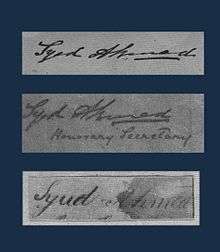
By 1873, the committee under Sir Syed issued proposals for the construction of a college in Aligarh. He began publishing the journal Tahzib-al-Akhlaq (Social Reformer) on 24 December 1870 to spread awareness and knowledge on modern subjects and promote reforms in Muslim society.[46] Sir Syed worked to promote reinterpretation of Muslim ideology in order to reconcile tradition with Western education. He argued in several books on Islam that the Qur'an rested on an appreciation of reason and natural law, making scientific inquiry important to being a good Muslim. Sir Syed established a modern school in Aligarh and, obtaining support from wealthy Muslims and the British, laid the foundation stone of the Muhammadan Anglo-Oriental College on 24 May 1875. He retired from his career as a jurist the following year, concentrating entirely on developing the college and on religious reform.[19] Sir Syed's pioneering work received support from the British. Although intensely criticised by orthodox religious leaders hostile to modern influences, Sir Syed's new institution attracted a large student body, mainly drawn from the Muslim gentry and middle classes.[38] The curriculum at the college involved scientific and Western subjects, as well as Oriental subjects and religious education.[19] The first chancellor was Sultan Shah Jahan Begum, a prominent Muslim noblewoman, and Sir Syed invited an Englishman, Theodore Beck, to serve as the first college principal.[38] The college was originally affiliated with Calcutta University but was transferred to the Allahabad University in 1885. Near the turn of the 20th century, it began publishing its own magazine and established a law school. In 1920, the college was transformed into a university.
Political career
In 1878, Sir Syed was nominated to the Viceroy's Legislative Council.[47] He testified before the education commission to promote the establishment of more colleges and schools across India. In the same year, Sir Syed founded the Muhammadan Association to promote political co-operation amongst Indian Muslims from different parts of the country. In 1886, he organised the All India Muhammadan Educational Conference in Aligarh, which promoted his vision of modern education and political unity for Muslims. His works made him the most prominent Muslim politician in 19th century India, often influencing the attitude of Muslims on various national issues. He supported the efforts of Indian political leaders Surendranath Banerjee and Dadabhai Naoroji to obtain representation for Indians in the government and civil services. In 1883, he founded the Muhammadan Civil Service Fund Association to encourage and support the entry of Muslim graduates into the Indian Civil Service (ICS).[19][48] While fearful of the loss of Muslim political power owing to the community's backwardness, Sir Syed was also averse to the prospect of democratic self-government, which would give control of government to the Hindu-majority population:[49][50]
"At this time our nation is in a bad state in regards education and wealth, but God has given us the light of religion and the Quran is present for our guidance, which has ordained them and us to be friends. Now God has made them rulers over us. Therefore we should cultivate friendship with them, and should adopt that method by which their rule may remain permanent and firm in India, and may not pass into the hands of the Bengalis... If we join the political movement of the Bengalis our nation will reap a loss, for we do not want to become subjects of the Hindus instead of the subjects of the "people of the Book..."[50]
Later in his life he said, "Suppose that the English community and the army were to leave India, taking with them all their cannons and their splendid weapons and all else, who then would be the rulers of India?.... Is it possible that under these circumstances two nations—the Mohammedans and the Hindus—could sit on the same throne and remain equal in power? Most certainly not. It is necessary that one of them should conquer the other. To hope that both could remain equal is to desire the impossible and the inconceivable. But until one nation has conquered the other and made it obedient, peace cannot reign in the land."[51]
All-India Muslim League
Sir Syed's educational model and progressive thinking inspired Muslim elites who supported the AIML. Ahmad Khan founded the All India Muhammadan Educational Conference in 1886 in order to promote Western education, especially science and literature, among India's Muslims. The conference, in addition to generating funds for Ahmad Khan's Muhammadan Anglo-Oriental College, motivated Muslim elites to propose expansion of educational uplift elsewhere, known as the Aligarh Movement. In turn this new awareness of Muslim needs helped stimulate a political consciousness among Muslim elites that went on to form the AIML.[52]
Overall, Syed Ahmed is hailed as a Muslim social reformer who promoted communal harmony and peaceful coexistence of all communities in India. In an undivided India under the British rule, he was worried about Muslim backwardness and unwillingness to adopt modern education. He worked towards social and educational upliftment of Muslims so as to enable them to walk shoulder to shoulder with all other communities in India.
Commemorative postage stamps issued in India and Pakistan
- India Post issued a commemorative postage stamp in his honor on his 156th birth anniversary - 17 October 1973.[53]
- Later, Pakistan Postal Services also issued a commemorative postage stamp in his honor in 1990 in its 'Pioneers of Freedom' series.[54]
Legacy and Knighthood
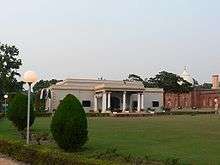
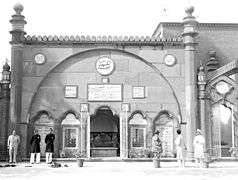
Syed Ahmad is widely commemorated across South Asia as a great Muslim social reformer and visionary.[19][48] At the same time, Syed Ahmad sought to politically ally Muslims with the British government. An avowed loyalist of the British Empire, he was nominated as a member of the Civil Service Commission in 1887 by Lord Dufferin. In 1888, he established the United Patriotic Association at Aligarh to promote political co-operation with the British and Muslim participation in the British government.
Syed Ahmed was bestowed with the suffix of 'Khan Bahadur' and was subsequently knighted by the British government in 1888 and was awarded Knight Commander of the order of Star of India (KCSI) [55] for his loyalty to the British crown, through his membership of the Imperial Legislative Council[56] and in the following year he received an LL.D. honoris causa from the Edinburgh University.[19][57]
Sir Syed Ahmed Khan Bahadur lived the last two decades of his life in Aligarh, regarded widely as the mentor of 19th and 20th century Muslim entrepreneurs and illuminati. Battling illnesses and old age, Sir Syed died on 27 March 1898. He was buried besides Sir Syed Masjid inside the campus of the Aligarh university.
The university he founded remains one of India's most prominent institutions. Prominent alumni of Aligarh include Muslim political leaders Maulana Mohammad Ali Jouhar, Abdur Rab Nishtar, Maulana Shaukat Ali and Maulvi Abdul Haq, who is hailed in Pakistan as Baba-e-Urdu (Father of Urdu). The first two Prime Ministers of Pakistan, Liaquat Ali Khan and Khawaja Nazimuddin, as well as Indian President Dr. Zakir Hussain, are amongst Aligarh's most famous graduates. In India, Sir Syed is commemorated as a pioneer who worked for the socio-political upliftment of Indian Muslims.
See also
References
- ↑ "Sir Syed Ahmad Khan | Genealogy of Sir Syed". www.sirsyedtoday.org. Retrieved 2017-10-17.
- ↑ Reetz, Dietrich. "Enlightenment and Islam: Sayyid Ahmad Khan's Plea to Indian Muslims for Reason". The Indian Historical Review, Delhi.
- 1 2 Glasse, Cyril, The New Encyclopedia of Islam, Altamira Press, (2001)
- ↑ Encyclopedia of Islam and the Muslim World, Thompson Gale (2004)
- ↑ "Beacon in the dark- The Express Tribune". The Express Tribune. 2014-10-27. Retrieved 2018-04-16.
- ↑ "Two-nation theory: Aligarh boys remember Sir Syed Ahmed Khan - The Express Tribune". The Express Tribune. 2011-10-19. Retrieved 2018-04-16.
- ↑ "Sir Syed Ahmad Khan-Man with a Great Vision". www.irfi.org. Retrieved 2016-09-13.
- ↑ "Sir Syed Ahmad Khan | The greatest Muslim reformer and statesman of the 19th Century". 2003-06-01. Retrieved 2016-09-11.
- ↑ "Sir Sayyid Ahmad Khan | Muslim scholar". Retrieved 2016-09-11.
- ↑ "Why Sir Syed loses and Allama Iqbal wins in Pakistan – The Express Tribune". 2013-02-08. Retrieved 2016-09-11.
- ↑ "'Commercialisation of Sir Syed's name': Court seeks input from city's top managers – The Express Tribune". 2012-02-01. Retrieved 2016-09-11.
- ↑ "Sir Syed Day: Why October 17 Is Important For AMU And Its Alumni".
- ↑ "Mukherjee calls for research at AMU celebration". The New Indian Express. Retrieved 2017-10-27.
- ↑ Hayaat-e-Javaid, Maulana Altaf Husain Haali, Vol. 1, pp. 26, Arsalaan Books, Allama Iqbal Road, Azad Kashmir
- ↑ GRAHAM, George Farquhar (1885). The Life and Work of Syed Ahmed Khan, C. at S. L. Black wood. p. 1.
- 1 2 3 4 5 "Sir Syed Ahmad Khan". Story of Pakistan. Retrieved 2006-10-14.
- ↑ GRAHAM, George Farquhar (1885). The Life and Work of Syed Ahmed Khan, C. S. L. Blackwood. p. 4.
- ↑ Syed Ziaur Rahman, Sir Syed and His Family Background, The norad Magazine, Aligarh Muslim University, Aligarh, 1998–99, p. 17-19; We and You (Special Issue), Aligarh, Sept–Oct., 1999, p. 10
- 1 2 3 4 5 6 7 "Sir Syed Ahmed Khan". Encyclopedia of World Biography (2nd ed.). Gale Research. 1997. pp. 17 vols.
|access-date=requires|url=(help) - 1 2 3 "Sir Syed Ahmad Khan". Nazaria-e-Pakistan. Story of Pakistan, Sir Syed. Retrieved 27 March 2014.
- ↑ GRAHAM, George Farquhar (1885). The Life and Work of Syed Ahmed Khan, C. S. L. Blackwood. p. 7.
- 1 2 Hayat-i-Javed (A Biography of Sir Sayyid) by Altaf Husain Hali (1901), translated by David J. Matthews (New Delhi: Rupa and Company, 1994)
- 1 2 "Sir Syed Ahmad Khan – Chronology". Sir Syed University of Engineering and Technology. Missing or empty
|url=(help);|access-date=requires|url=(help) - ↑ MUHAMAD, Dr. Shan (1978). The Aligarh Movement. Meerut: Meenakshi Prakashan. pp. IX.
- ↑ Hoodbhoy, Pervez (9 Feb 2013). "Why Sir Syed loses and Allama Iqbal wins in Pakistan". The Pakistan Tribune. Retrieved 30 July 2015.
- ↑ Hayat-i-Javed (A Biography of Sir Sayyid) by Altaf Husain Hali (1901), translated by David J. Matthews (New Delhi: Rupa and Company, 1994), pp. 92–95 |date=December 2011
- ↑ See, for instance, chapter 2 of Raja, Masood Ashraf. Constructing Pakistan: Foundational Texts and the Rise of Muslim National Identity, 1857–1947, Oxford 2010, ISBN 978-0-19-547811-2
- ↑ Hayat-i-Javed (A Biography of Sir Sayyid) by Altaf Husain Hali (1901), translated by David J. Matthews (New Delhi: Rupa and Company, 1994), pp. 92–95
- ↑ The word a’in can mean all or any of the following: character, convention, temperament, habit, rule, path, law (ecclesiastical or secular), creed, praxis, quality, intention, organization, management, system, decoration, beauty. (Lughat Nama-e Dehkhoda). There are about eighty meanings in all. These meanings seem to have developed over the centuries. Most were available to Abul Fazl; all were available to Ghalib.
- ↑ Faruqi, Shamsur Rahman. "From Antiquary to Social Revolutionary: Syed Ahmad Khan and the Colonial Experience" (PDF). Shamsur Rahman Faruqi, work in English. Columbia University. Retrieved 12 December 2015.
- ↑ John W. Wilder(2006), Selected essays by Sir Sayed Ahmad Khan, p. 34
- ↑ Johannes Marinus Simon Baljon(1964), The reforms and religious ideas of Sir Sayed Ahmad Khan, p. 13
- ↑ Sir Syed Ahmed Khan >> Chronology Archived 9 July 2009 at the Wayback Machine.
- ↑ Cementing Ethics with Modernism: An Appraisal of Sir Sayyed Ahmed Khan's Writings. Gyan Publishing House. 2010-01-01. ISBN 9788121210478.
- ↑ Compiled by: Ashraf A. Shah, 1980
- 1 2 3 4 KUMAR, S (2000). Educational Philosophy in Modern India. Anmol Publications Pvt. Ltd. p. 59. ISBN 81-261-0431-7.
- ↑ Tafsir al Quran, v.1 p.3016, translated and quoted in Baljon 1964: 44–45
- 1 2 3 Nazeer Ahmed (2000). Islam in Global History. Xlibris Corporation. p. 231. ISBN 0-7388-5966-4.
- ↑ Panipati, Muhammad Ismail (1995). Khutoot banaam Sir Syed. Lahore, Pakistan: Majlis Taraqqi e Adab Lahore. pp. 249–263.
- ↑ Balijon, J.M.S. (1964). The Reforms and Religious Ideas of Sir Sayyid Ahmad Khan. Lahore: S.M. Ashraf. p. 108.
- ↑ Balijon, J.M.S. (1964). The Reforms and Religious Ideas of Sir Sayyid Ahmad Khan. Lahore: S.M. Ashraf. p. 106.
- ↑ Panipati, Muhammad Ismail (1995). Khutoot banaam Sir Syed. Lahore, Pakistan: Majlis Taraqqi e Adab Lahore. p. 102.
- ↑ Panipati, Muhammad Ismail (1995). Khutoot banam Sir Syed. Lahore, Pakistan: Majlis e Taraqqi e Adab Lahore. p. 100.
- ↑ Hindi Nationalism, Alok Rai, Orient Blackswan, 2001
- ↑ ABBASI, Yusuf (1981). Muslim Politics and Leadership in the South Asian Sub-continent. Institute of Islamic History, Culture and Civilization, Islamic University (Islamabad). p. 90.
- ↑ http://aligarhmovement.com/Chronology_of_Aligarh_Movement, Syed Ahmad Khan launches the journal 'Tahzib-al-Akhlaq' on 24 December 1870 on aligarhmovement.com website, Retrieved 14 February 2017
- ↑ GRAHAM, George Farquhar (1885). The Life and Work of Syed Ahmed Khan, C. S. L. Blackwood. p. 289.
- 1 2 MAJUMDAR, RC (1969). Struggle for Freedom. Bharatiya Vidya Bhavan. p. 1967. ASIN: B000HXEOUM.
- ↑ BAIG, MRA (1974). The Muslim Dilemma in India. Delhi: Vikas Publishing House. pp. 51–2.
- 1 2 KUMAR, S (2000). Educational Philosophy in Modern India. Anmol Publications Pvt. Ltd. p. 60. ISBN 81-261-0431-7.
- ↑ Sir Syed Ahmed Khan (1817–1898), Speech in March 1888, Quoted by Dilip Hiro, "The Longest August: The Unflinching Rivalry Between India and Pakistan"
- ↑ Abdul Rashid Khan, "All India Muhammadan Educational Conference and the Foundation of the All India Muslim League," Journal of the Pakistan Historical Society (2007) Vol. 55 Issue 1/2, pp 65–83.
- ↑ http://www.indianpost.com/viewstamp.php/Alpha/SYED%20AHMAD%20KHAN%20ALIGARH%20UNIVERSITY, Syed Ahmad Khan's commemorative postage stamp issued by India Post in 1973 commemorating his 156th birthanniversary, Retrieved 17 October 2017
- ↑ http://www.findpk.com/pof/pioneers_of_freedom_1.html, Syed Ahmad Khan's commemorative postage stamp issued by Pakistan Postal Services in 1990 in its 'Pioneers of Freedom' series, Retrieved 30 January 2017
- ↑ Ikram, S.S. Sir Sayyid Ahmad Khan: Muslim Scholar. Encyclopædia Britannica. Retrieved 30 July 2015.
- ↑ Mondal, Puja. "Sir Syed Ahmed Khan and the Aligarh Movement". Retrieved 30 July 2015.
- ↑ "A Musafir To London". Retrieved 2016-05-29.
Further reading
- The Glowing Legend of Sir Syed – A Centennial Tribute (1998), Ed. Syed Ziaur Rahman, Non-Resident Students' Centre, Aligarh
Muslim University (Aligarh)
- Prof. Iftikhar Alam Khan. Sir Syed aur Faney TameerSir Syed Academy, AMU. Aligarh
- Prof. Iftikhar Alam Khan. Muslim University ki Kahani, Imarton ki zubani Educational publications, civil Lines, (Aligarh)
- Prof. Iftikhar Alam Khan. Sir Syed aur Scientific SocietyPub by Sir Syed Academy, AMU.Aligarh.
- Prof. Iftikhar Alam Khan. Sir Syed tahreek ka siyasi aur samaji pas manzarEducational Publishing house, Dhula Kounan, Delhi
- Prof. Iftikhar Alam Khan. Sir Syed House ke Mah Wasal (Aligarh)
- Prof. Iftikhar Alam Khan. Sir Syed Daroon e Khana Educational Publications, Civil Lines. Aligarh
- Prof. Iftikhar Alam Khan " Sir Syed aur Jadeedyat" Pub. by Educational Publications, Delhi 012.
- Prof. Iftikhar Alam Khan " Sir Syed aur Hindustani Nizam-e-zaraat " Educational Publishing. Delhi.
- Prof, Iftikhar Alam Khan "Sir Syed Ka Nazaria-e-Talim". Educational Publishing House, Delhi, 2017.
Graham, George Farquhar Irving. The Life and Work of Sir Syed Ahmed Khan (Karachi: Oxford University Press, 1974)
External links
| Wikiquote has quotations related to: Syed Ahmad Khan |
| Wikimedia Commons has media related to Syed Ahmed Khan. |
- Comprehensive detail about Aligarh Movement
- "Sir Saiyad Ahmad, Khan Bahadur, L.L.D, K.C.S.I." By Afzal Usmani
- "Sir Syed Ahmad Khan short biography". official website of Aligarh Muslim University. Archived from the original on 1 May 2012.
- "Sir Syed Today: A Source of Literary Work of Sir Syed Ahmad Khan".
- "Sir Syed Ahmad Khan (1817–1898)". Story of Pakistan.
- "Sir Syed Ahmad Khan". Pioneers of Freedom.
- "Sir Syed Ahmed Khan". Sir Syed University of Engineering & Technology. Archived from the original on 30 September 2007.
- "Sir Syed Ahmad Khan". Cyber AMU. Archived from the original on 29 September 2007.
- Upadhyay, R. "Aligarh Movement". South Asia Analysis Group. Archived from the original on 28 February 2005.
- The Rich Legacy of Sir Syed Ahmad Khan (Gulf News)
- Sir Syed Ahmed Khan His Life and Contribution (NewAgeIslam)
- Pioneers of the Nation (Mai Nahi Manta)
